
Pandemis cerasana, the barred fruit-tree tortrix, is a moth of the family Tortricidae.

Archips semiferanus is a species of moth in the family Tortricidae, and one of several species of moth commonly known as oak leafroller or oak leaf roller. The larvae feed on the leaves of oak trees in the eastern United States and southeastern Canada and are a major defoliator of oak trees, which can lead to tree mortality. In Pennsylvania in the late 1960s and early 1970s, oak leafrollers defoliated over 1,045,000 acres (423,000 ha).

Archips negundana, the larger boxelder leafroller, is a moth of the family Tortricidae. The species was first described by Harrison Gray Dyar Jr. in 1902. It is found in North America from southern British Columbia to southern Quebec, south to California and Florida.
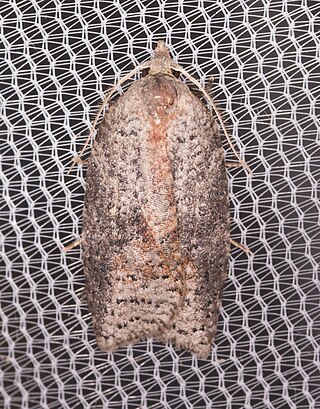
Amorbia humerosana, the white-lined leafroller, is a species of moth of the family Tortricidae. It is found from the Gulf states to the northeastern United States and southeastern Canada.

Amorbia cuneanum, the western avocado leafroller moth, is a species of moth of the family Tortricidae. It is found from Baja California, Mexico, to south-western Canada. To the east, the range extends to Arizona and Idaho in the United States.
Apotomops wellingtoniana is a species of moth of the family Tortricidae first described by William D. Kearfott in 1907. It is found in North America from British Columbia to Nova Scotia, south through the Rocky Mountains to the Mexican states of Durango, Nuevo Leon, Distrito Federal and Veracruz. In the east, it ranges south to the Great Smoky Mountains in Tennessee. The habitat consists of coniferous forests.
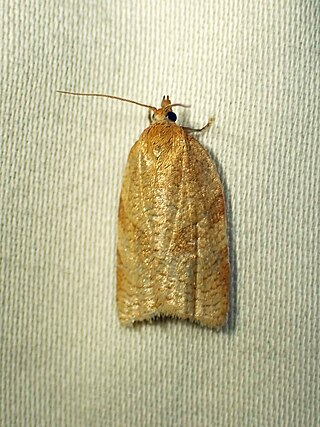
Aphelia alleniana, the wide-striped leafroller, is a species of moth of the family Tortricidae. It is found in North America, where it has been recorded throughout Canada, as far north as Alaska. In the United States, it has been recorded from Colorado, Maine and Montana.
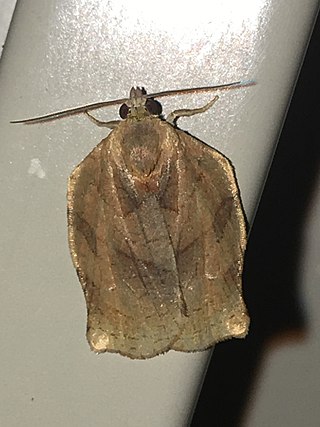
Archips purpuranus, the omnivorous leafroller moth, is a species of moth of the family Tortricidae. It is found in most of eastern North America.
Argyrotaenia kimballi, Kimball's leafroller moth, is a species of moth of the family Tortricidae. It is found in the United States, where it has been recorded from Alabama, Florida, Louisiana, Maryland, Mississippi, North Carolina, South Carolina, Tennessee and Texas.

Argyrotaenia provana is a species of moth of the family Tortricidae. It is found in North America, where it has been recorded from Arizona, British Columbia, California, Colorado, New Mexico, Utah, Washington and Wyoming.
Argyrotaenia quadrifasciana, the four-lined leafroller moth, four-banded leafroller or lesser all-green leafroller, is a species of moth of the family Tortricidae. It is found in North America, where it has been recorded from Nova Scotia to West Virginia, west to Arkansas and north to Alberta. The habitat consists of orchards and shrubby areas.
Argyrotaenia occultana, the fall spruce needle moth, is a moth of the family Tortricidae. The species was first described by Thomas Nesbitt Freeman in 1942. It is found in North America, where it has been recorded from British Columbia north to Yukon and Northwest Territories, east to Newfoundland and south to Kentucky and Oregon. The habitat consists of spruce forests.
Choristoneura biennis, the two-year-cycle budworm moth, is a species of moth of the family Tortricidae. It is found in Canada, where it has been recorded from Alberta and British Columbia.
Choristoneura carnana is a species of moth of the family Tortricidae first described by William Barnes and August Busck in 1920. It is found in the United States, where it has been recorded from California and Colorado.
Choristoneura retiniana is a species of moth of the family Tortricidae. It is found in the United States, where it has been recorded from California and Nevada.
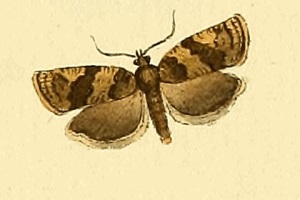
Choristoneura diversana is a species of moth of the family Tortricidae. It is found in Great Britain, France, Belgium, the Netherlands, Germany, Denmark, Austria, Switzerland, Italy, the Czech Republic, Slovakia, Slovenia, Poland, Bulgaria, Hungary, Romania, Norway, Sweden, Finland, the Baltic region, Russia and the Near East. In the east, the range extends to China (Heilongjiang), Korea and Japan. The habitat consists of gardens, scrub and fens.

Choristoneura lafauryana, the strawberry leafroller, is a species of moth of the family Tortricidae. It is found in Spain, Great Britain, the Netherlands, Belgium, France, Germany, Switzerland, Italy, Romania and Russia. In the east, the range extends to China, Korea and Japan.

Choristoneura evanidana is a species of moth of the family Tortricidae. It is found in the Russian Far East, Korea and China.
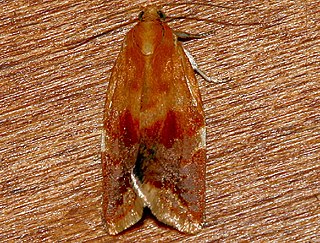
Clepsis persicana, the white triangle tortrix or the green needleworm, is a species of moth of the family Tortricidae. It is found in North America, where it has been recorded from Alaska and British Columbia to Newfoundland and south to Virginia and west to California. The habitat consists of coniferous and mixed coniferous forests.
Syndemis cedricola, the Lebanese cedar shoot moth, is a species of moth of the family Tortricidae. It is found in Lebanon and Turkey.











